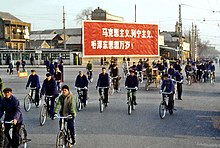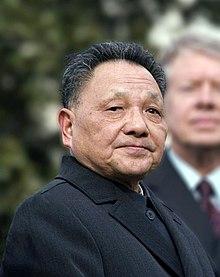Maoism
Later theoreticians expanded on the idea that Mao had adapted Marxism–Leninism to Chinese conditions, arguing that he had in fact updated it fundamentally and that Maoism could be applied universally throughout the world.[8]: 12–16 By the turn of the 20th century, a proportionately small yet socially significant cross-section of China's traditional elite (i.e., landlords and bureaucrats) found themselves increasingly sceptical of the efficacy and even the moral validity of Confucianism.[8]: 17 The adverse reaction culminated in the May Fourth Movement in 1919, during which a protest began with 3,000 students in Beijing displaying their anger at the announcement of the Versailles Treaty's concessions to Japan.[8]: 45 The rudimentary philosophical base of Chinese Communist ideology is laid down in Mao's numerous dialectical treatises and was conveyed to newly recruited party members.A recent example of a Chinese politician regarded as neo-Maoist in terms of political strategies and mass mobilisation via red songs was Bo Xilai in Chongqing.In Deng's day, support of radical Maoism was regarded as a form of "left deviationism" and based on a cult of personality, although these "errors" are officially attributed to the Gang of Four rather than Mao himself.In the 2020s, influenced by the growing wealth gap and the 996 working hour system, Mao's thoughts are being revived in China's generation Z, as they question authority of the CCP.Mobilizing large parts of rural populations to revolt against established institutions by engaging in guerrilla warfare, Maoist Thought focuses on "surrounding the cities from the countryside".Practical examples of this theory's application can be seen in the rapid social changes undergone by post-revolution Soviet Union in the late 1920s -1930s[39] as well as pre-revolution China in the New Culture and May Fourth movements of the 1910s-1920s.Thus, in each of these realms (economic, scientific, and political practice), contradictions (principle and secondary) must be identified, explored, and put to function to achieve the communist goal.This involves the need to know "scientifically" how the masses produce (how they live, think and work), to obtain knowledge of how class struggle (the central contradiction that articulates a mode of production in its various realms) expresses itself.Notably, Maoist parties in Peru, Nepal, and the Philippines have adopted equal stresses on urban and rural areas, depending on the country's focus on economic activity.Maoism broke with the framework of the Soviet Union under Nikita Khrushchev, dismissing it as "state capitalist" and "revisionist", a pejorative term among communists referring to those who fight for capitalism in the name of socialism and who depart from historical and dialectical materialism.Under the leadership of the CCP and Mao Zedong, a parallel international communist movement emerged to rival that of the Soviets, although it was never as formalised and homogeneous as the pro-Soviet tendency.When it became clear that the differences between the pro-Moscow leadership and the pro-Beijing wing were too significant, Grippa and his entourage decided to split from the CPB and formed the Communist Party of Belgium – Marxist–Leninist (PCBML).This Maoist group originated primarily from students from the universities of Leuven and Ghent but did manage to gain some influence among the striking miners during the shutdowns of the Belgian stone coal mines in the late 1960s and early 1970s.[citation needed] In the 1980s and 1990s, the Maoist-inspired group Shining Path waged a bloody insurgency against the Peruvian state that resulted in tens of thousands of deaths.[70] After the tumultuous 1960s (particularly the events of 1968, such as the launch of the Tet Offensive, the assassination of Martin Luther King Jr., nationwide university protests, and the election of Richard Nixon), proponents of Maoist ideology constituted the "largest and most dynamic" branch of American socialism.[71] Among the many Maoist principles, the group of aspiring American revolutionaries sympathized with the idea of a protracted people's war, which would allow citizens to address the oppressive nature of global capitalism martially.Mounting discontent with racial oppression and socioeconomic exploitation birthed the two largest, officially-organized Maoist groups: the Revolutionary Communist Party and the October League.[71] Orchestrated by The Guardian, in the spring of 1973, an attempt to conflate the strands of American Maoism was made with a series of sponsored forums titled "What Road to Building a New Communist Party?""[75] The Americans' burgeoning Maoist and Marxist–Leninist movements proved optimistic for a potential revolution, but "a lack of political development and rampant rightist and ultra-leftist opportunism" thwarted the advancement of the greater communist initiative.[77][78] Nearly a decade after the Sino-Soviet split, this newfound amiability between the two nations quieted American-based counter-capitalist rumblings and marked the steady decline of American Maoism until its unofficial cessation in the early-1980s.[80][81][82][83] In 1971, a year before Nixon's monumental visit, BPP leader Huey P. Newton landed in China, whereafter he was enthralled with the mystical East and the achievements of the Chinese Communist Revolution.[84] After his return to the United States, Newton said that "[e]verything I saw in China demonstrated that the People's Republic is a free and liberated territory with a socialist government" and "[t]o see a classless society in operation is unforgettable".[85] In general, Newton's first encounter with anti-capitalist society commenced a psychological liberation and embedded within him the desire to subvert the American system in favor of what the BPP called "revolutionary intercommunalism".[84] The words of Mao, quoted liberally in BPP speeches and writings, served as a guiding light for the party's analysis and theoretical application of Marxist ideology.[88] Chinese scholars generally agree that Deng's interpretation of Maoism preserves the legitimacy of Communist rule in China but simultaneously criticizes Mao's brand of economic and political governance.[90] Enver Hoxha critiqued Maoism from a Marxist–Leninist perspective, arguing that New Democracy halts class struggle[91] and allows unrestricted capitalist exploitation,[91] that the theory of the three worlds is "counter-revolutionary",[92] and questioned Mao's guerilla warfare methods.[8]: 44 Jung Chang and Jon Halliday contend that implementation of Maoist thought in China was responsible for as many as 70 million deaths during peacetime,[94] with the Cultural Revolution, the Anti-Rightist Campaign of 1957–1958,[95] and the Great Leap Forward.









Maoist (novel)Simplified ChineseTraditional ChineseStandard MandarinHanyu PinyinBopomofoWade–GilesYue: CantoneseYale RomanizationJyutpingAgrarian socialismAntagonistic contradictionAnti-imperialismAnti-revisionismCapitalist roaderCompradorContinuous revolution theoryCultural RevolutionFour OldsMarxism–LeninismMass lineNewborn socialist thingsNew DemocracyOne Divides into TwoPeople's warProbable defeatRevolutionary base areaSeek truth from factsSelf-criticismSocial imperialismThree Worlds TheoryMaoism–Third WorldismMao-spontexMarxism–Leninism–MaoismGonzalo ThoughtPrachanda PathMao ZedongFaiz AhmadLouis AlthusserSamir AminBob AvakianAlain BadiouMohan BaidyaAfzal BangashCharles BettelheimBiplavBo XilaiChen BodaChin PengPushpa Kamal DahalSaroj DuttaNorm GallagherAbimael GuzmánHarry HaywoodTed HillGeorge Jacksonİbrahim KaypakkayaJiang QingKang ShengLi MinqiLin BiaoCharu MajumdarPierre MuleleHuey P. NewtonNie YuanziQi BenyuMuppala Lakshmana RaoNarayan SanyalSiraj SikderJose Maria SisonWang HongwenYao WenyuanAkram YariZhang ChunqiaoReport on an Investigation of the PeasantMovement in HunanOn ContradictionOn PracticeOn Guerrilla WarfareOn Protracted WarOn the Ten Major RelationshipsOn the Correct Handling of ContradictionsAmong the PeopleA Critique of Soviet EconomicsQuotations from Chairman Mao Tse-tungHistoric Eight DocumentsBombard the HeadquartersChinese Soviet RepublicJiangxi SovietLong MarchChinese Communist RevolutionPeople's Republic of China1949–19761976–19891989–20022002–presentCampaign to Suppress CounterrevolutionariesKorean WarSino-Soviet splitGreat Leap ForwardBlack Power movement16 May NotificationRed AugustJanuary StormDown to the Countryside MovementNew Communist movementCambodian Civil WarNaxalite–Maoist insurgencyNaxalbari uprisingNew People's Army rebellionSino-Albanian splitMaoist insurgency in TurkeyDeath and funeral of MaoCambodian–Vietnamese WarTwo WhateversInternal conflict in PeruNepalese Civil WarChongqing modelChinese Communist PartyCommunist Party of Peru – Shining PathNational Democratic Front of the PhilippinesCommunist Party of the PhilippinesNew People's ArmyCommunist Party of Turkey/Marxist–LeninistCommunist Party of Nepal (Maoist Centre)Communist Party of India (Maoist)Purba Banglar Sarbahara PartyCommunist Party of Burma

